Bergama (Pergamon)
Medicine, written knowledge and Zeus is the glory of Pergamon- the name of the ancient city found in the district of Bergama, 100 km from İzmir. Pergamon was one of the important trade centres in the Mysian region during the ancient period. On becoming the capital of the Kingdom of Pergamon between 282 – 133 BC, the city was thus named after Pergamos, a legendary king. By killing the King of Teuthrania, Pergamos captured the city, and so gave it his name. According to another legend, Gyrnos, the King of Teuthrania, asked Pergamos for help during a battle and after the victory, two cities were built, one of them being named Pergamon in commemoration of Pergamos and the other Gryneion after Gyrnos.
Pergamon was first mentioned in written documents early in the 4th century B.C. Buildings such as palaces, temples and theatres were built in the city when it became the capital, and the city was surrounded by perimeter walls and towers. After it was annexed to Rome, the Kingdom remained as one of the leading cities in Western Anatolia.
The City of Pergamon, which was an independent kingdom in 283 BC, maintained its importance as a major historical, cultural and commercial centre for a period of 150 years.
Because Alexander the Great hid his famous treasure at Pergamon Castle the city was a focus of interest to its enemies. Its conquest was top of the list for a number of kingdoms and civilizations.
Carl Humann, a German engineer who worked on railway track installation in Western Anatolia in the 1870’s, discovered the ruins of the ancient city. Soon afterwards, in 1878, research and archaeological works began in Pergamon. Excavation and restoration work is ongoing.
An important health care centre in ancient times Asclepion situated to the southwest of Pergamon, the Acropolis located in the first settlement on a steep hill at a height of 300 m. and the Temple of Serapis (Red Courtyard) dating back to the 2nd century all contribute significantly to the local cultural heritage.
The famous Altar of Zeus, which was originally in the Acropolis, was taken to Germany in 1897 and it is presently on exhibition at the Pergamon Museum in Berlin.
Bergama is a lovely district famous for its beauty spas, Kozak Plateau, advanced levels of weaving and rug production.
In addition to its position as an important city with magnificent monuments, as a capital of a kingdom bearing the same name in the ancient period, the city was also an important strategic centre in the Medieval Period, a capital for Karesioğulları Principality and finally, one of the leading centres of the Ottoman Empire.
Acropolis
The acropolis, literally meaning “a high city”, was built on top of a very steep hill. A winding path provides access to this hill that is about 300 meters high. The most distinctive feature of the acropolis was the special layout given to a series of buildings that accommodated any religious,
military, governmental, social and commercial usage. Having served as a settlement since ancient times, the top of the hill accommodates the Palaces of the Kings of Pergamon, five water depots and an armoury supplies chamber.
The Temple of Athena is located in the lower section of the buildings. In addition, there are libraries and the Temple of Trajan. The Altar of Zeus was built with much care and precision on the terrace beneath them. This site is also home to one of the steepest theatres in the world. A Gymnasium (Sports School) and the Temple of Demeter are situated in the lowest section.
Temple of Athena
Built on a terrace on top of the theatre, the Temple of Athena is a structure in Doric style, with columns of 6 x 10 m. Only some pieces from the foundations of the temple have survived to the present day, although its western wing, up to a height of 1.20m has been preserved. Pergamon Museum of Berlin presently exhibits the columns and frontal sections of the temple. The fact that the most significant temple in the city was devoted to the Goddess Athena reflects the deep-rooted tradition in
Western Anatolia. This was the case in many other ancient cities such as Assos, Erythrai, Phocaea, Symrna and Miletus.
The Temple of Athena was the oldest temple built in ancient times, and was built in commemoration of the Goddess Athena, the messenger of victory, who was believed to be the protector of science, arts and cities. There is an inscription on a column piece excavated in this location, which reads: “Oh, the Goddess who was born of Triton, the son of Artemo has erected this for you”. A church was built on the temple site in the Byzantine Period (4th century).
Pergamon Library
This building, which was the second most important library in ancient times, after the library in Alexandria, is situated to the north of the sacred site of Athena. The library, which originally was accessed through the upper floor of the gallery, accommodates a large reading room from the era of Eumenes II. The library was equipped with shelves, and 3.50 m. high Statue of Athena that was originally in there, is now in the Berlin Museum. In the time of Eumenes II, the collection of the Pergamon Library became richer and the Alexandria Library was its biggest rival. Enjoying much fame and popularity in the 2nd century B.C., Pergamon Library was built by Attalos I. The library housed the statue busts of the historian Herodotus from Halicarnassus, a female poet Sappho from
Lesbos, the scholar Appolonious, who was the son of Philotas, vellum makers Krates and Irodikos and the musician Timotheous from Miletus.
Disturbed by the grandeur of Pergamon Library, the Egyptian King prohibited papyrus exports to Pergamon, in an attempt to weaken the competition. He wanted the Library in Alexandria to be unrivalled. Krates, an artist from Sardes, offered a solution to this problem. The material he made from goat leather was called Pergamon Paper (Pergaminae Charte), and this was successfully used in place of papyrus. This Pergamon Paper, which was a very important invention, later became known as Parchment. The invention of Parchment led to a rich literary collection in Pergamon. When the city came under the rule of Rome in 133 B.C., the works from the Pergamon Library were taken to Alexandria, and given to the Egyptian Queen Cleopatra as a gift from Antonius, ignoring the Roman scholars who wished to obtain them.
Palaces
The ruins of the Pergamon Kings’ palaces lie immediately to the east of the library and “eyvan”s (three-walled vaulted antechamber, open at the front), surrounding the Temple of Athena.
Arsenals
The Arsenals, known as “the depot for military supplies”, were located beyond the palaces and the Temple of Trajan, on the northern edge of the acropolis. These are five long structures parallel to each other.
7S-7212
Temple of Trajan
The temple was built for the Roman Emperor Trajan, who was deified by the Romans, and it was
built on the highest terrace in the acropolis. The temple, reaching a size of 68 x 58 m. was surrounded on three of its sides by the “eyvan”s. The giant marble statues of Trajan and Hadrian were found inside the Temple. The Temple was restored in 1990.
Theater
Pergamon Theatre, set on a steep slope, is one of the most beautiful architectural works from the period. The theatre, which is the steepest theatre in Western Anatolia, has a 10 thousand-seat capacity. The portable wooden stage building is unique - set up only on performance days and removed once the performance ended.
Temple of Dionysos
In the 2nd century the inhabitants of Pergamon built this eye catching temple on the north of the 250 m. theatre terrace and positioned it in such a way that a view over the whole area was possible. The temple and the altar are both in a well preserved condition. Rising up on a podium and built according to the Ionian design, it is a richly decorated temple. This work not only affected Roman
artistic understanding but also had ramifications on European Baroque architecture. At the end of a long road, this monument has become a work of art that has attracted enormous interest.
Temple of Zeus
The temple was dedicated to the God Zeus in commemoration of the victory of Attalos II against the Galatians during the Period of Eumenes II (197 – 159 B.C.). In his book titled “Wonders of the World”, L. Ampelius, a famous Roman writer, says about this magnificent altar: “There is a giant marble atlar in Pergamon, which is forty feet high and decorated with splendid reliefs. It depicts the war between the gods and the giants.” It is a very impressive piece of work, with its architectural style, the mythological subjects covered, the height of the relief’s and the giant like dimensions of the structure.
Agora
The upper agora is located to the south of the Altar of Zeus. Dedicated to Hermes, the God of Merchants, the agora was built in the Doric style. The foundations of the Temple of Demeter are visible on the western edge of the square.
Gymnasiums
In the city of Pergamon, three splendid gymnasiums were built on three separate terraces all in a row. It is understood from inscriptions uncovered that the lower terraces would have been used by children, and the central and upper terraces were allocated to youths and adults respectively.
Asclepion
Legend has it that Coronis, the daughter of the King of Thesselia, fell in love with a man when she
was carrying the God Apollo’s child. Learning of this, Apollo punished Coronis by burning her to death. However, before doing so, he saved the child in her womb, who was later to be named Asclepius. The child was put into the custody of Horse Man Kherion, so he could raise the child. Kherion made his living using healing waters and herbs, and as he raised Asclepius he taught him the science of medicine. However, the chief God Zeus was upset by Asclepius’ ability to bring the dead back to life and as a punishment; he killed Asclepius by casting lightning upon him. Deeply saddened, Apollo took his son Asclepius up into the sky, placing him among the zodiacs.
The snake, which is currently used as the symbol of health and medicine, is one of the symbols of
Asclepion. Asclepius is depicted as a bearded man wearing sandals on his feet. He is holding a sceptre with a snake wound around it. Among the historical buildings of the Asclepion temples dedicated to the health god Asclepius can be found. The site is one of the most famous healthcare centres discovered, and indeed is a fascinating place for people to visit.
Historical sources define the health care centre built by Arkias, the son of Aristohminos from Pergamon, in the 4th century B.C. as, “the location where death is prohibited and wills are never opened up”. Treatment methods that are employed in modern times included such practises as; the use of healing waters, mud baths, sports, theatre and psychotherapy, and these were carried out in the centre accessed by a columned street. Built approximately in the year 150, and built from donations received, situated immediately to the left was the Temple of Asclepion. Here treatment using water sounds was employed, as it was suggested that this was beneficial to patients’ recovery.
It is said that the first temple to become Pergamon’s Asclepion, was built on a rocky site near a sacred fountain, in the Ayvazali location. Sources say that the Asclepion reached a considerable state of development and the city was decorated with marble buildings in the Period of Pergamon Kingdom (280 – 133 B.C.).
Suffering a number of wars and devastation in the subsequent periods, the historical centre was rebuilt and expanded, along with Pergamon between 183 – 173 B.C. In that period, there was an Ionian style marble temple rising on the rocks, treatment halls, stone fountains, and a pool was in the process of being built to. However, in 156 B.C., the King of Bithynia looted Asclepion, taking with him to his country all the valuable statues and works of art. This included the Statue of Asclepius.
In the period of the Pergamon King Attalos III, the Asclepion Health
Centre was called “The Royal Sacred Place”. A statue of the king was placed next to the statue of the god, and animals were slaughtered and given as sacrifices to him. Asclepion regained its importance in the second half of the first century B.C., with corridors, pools and treatment areas being supplemented between 138 and161 B.C. The Orator Aristides, a major source for historians, arrived in Pergamon in the 2nd century, and is quoted as saying about the Asclepion: “I owe my health entirely to you, Asclepius and I am tied to you by a mysterious love.” A colossal earthquake in the 3rd century devastated the buildings. The Temple of Asclepion was used as a church following the spread of Christianity.
Red Basilica (Serapis Temple)
Popularly known as “Red Courtyard” because it was built of red bricks, this was the largest building in ancient Pergamon, and the temple was dedicated to the Egyptian gods. This temple is presently
located in the ancient city of Pergamon.The Byzantines preserved the sacred space, building the Church of St John the Apostle within the huge ancient walls. The building is sacred still today, as one of the Seven Churches of Apocalypse and containing theKurtuluş Mosque in one of its towers.
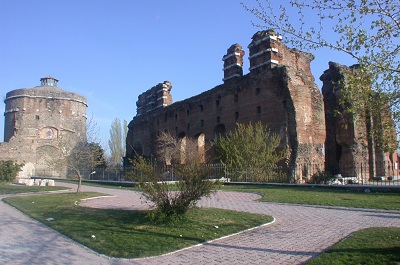
Ulu Mosque
Located on the left bank of Bergama Stream, and at the start of the road leading to Tekke Boğazı
(Pass), the Ulu Mosque was built in1398 – 1399. The mosque is based on a rectangular design structure.

Şadırvan Mosque
The mosque is situated next to the Seljuk Minaret in the location that is named after it. The marble
inscription on the door states that it was built by Hacı (Hadji) Hasan, the son of Osman, in 1550. It is understood that the “şadırvan” (fountain used for ritual ablutions and usually located in the
Did you know?
The natives of Pergamon invented Parchment, which replaced papyrus in ancient times.
middle of a mosque courtyard) found in the courtyard was built by Bergama Voivode Abdullah Aga in 1824.
Seljuk Minaret
The minaret is next to Şadırvan Mosque. The main building, “the Arab Mosque” fell down, and only its minaret has survived to the present day. It is also called “Güdük Minare” (Squat Minaret) and “Çinili Minare” (Minaret with Tiles). The style and decoration of the building prove that the minaret is a Seljuk building. Other historical buildings in Bergama include Kurşunlu Mosque, Hacı
Hekim Mosque at the bazaar, and a mosque on the road leading to Asclepion, the Yeni (New) Mosque and Emir Sultan Minaret.
Çukur Han
Based on its construction style, the Han (caravanserai / large commercial building) is believed to have been built in the 14th or 15th centuries.
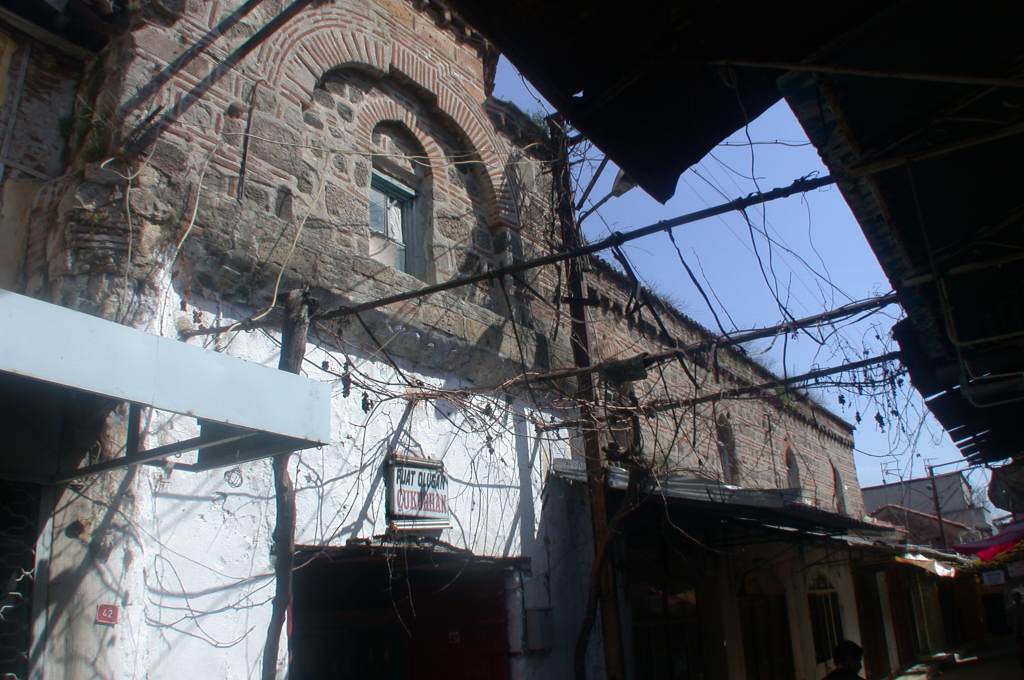
Taş Han
The Han is adjacent to Küplühamam (baths) on Rüştiye Mektebi Street. According to the inscription on its door, it was built by Hibeytullah, the son of Hatip Mahmut, in the time of Sultan Murat in 1432. The space where the inscription was found, displayed a polished stone and there was a Turkish style low arch (with 9 stones). Marble plates were placed below it.
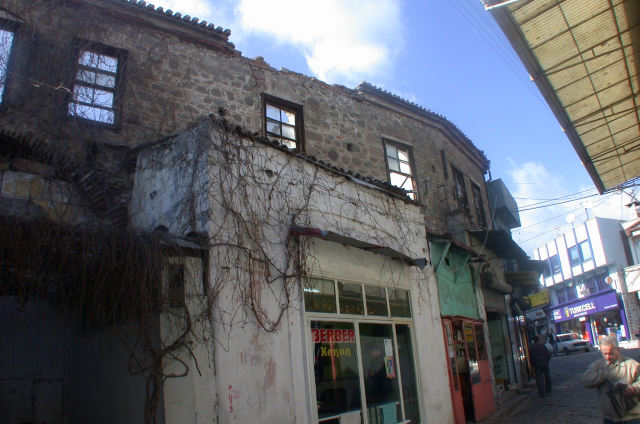
Kozak Plateau
Kozak Plateau, located 20 km. from Bergama is accessible via the road running between Bergama and Ayvalık. It is a sight particularly recommended for hiking enthusiasts, and people with in interest in the local woven products.
Beauty Spa
The Beauty Spa, situated 4km from Bergama, has a domed roof and is home to two marble pools with hot springs. The spa, built in the period of the Pergamon King Eumenes, enjoyed for centuries a long lasting reputation as “Eskülap Baths”. At present, the hot springs can be found in a wooded area, a very impressive natural attraction. The water temperature of the hot springs is about 35ᵒC. The spa water containing sodium bicarbonate and sulphate has healing effects, especially for rheumatism, neuralgia and heart conditions. It is rumoured that in ancient times Cleopatra bathed in
these hot springs, adding to her beauty and charm.
Houses of Bergama
Houses in Bergama possess special features that are a help in controlling the due to their thick outer walls, heat. This is interior design plan and window size. A traditional Turkish house, on the upper floor has no exterior exposure and lower and upper floors are usually of the same size. A small number of houses provide an exception to this feature, having a “cumba” (wooden latticework projection extending from the window) and projections in the form of balconies, which are specific to the architecture on the Island of Chios (Lesbos).
Did you know?
The Anatolian population since ancient times has used writing. The most ancient baked inscribed tablets unearthed at Kültepe Karum in Kayseri, which was one of the major centres from the Age of the Assyrian Trade Colonies, date back to 1950 B.C.
Bergama Archeological Museum
The Archaeological and Ethnographical Museum, originally built in 1924, was relocated to a modern building which was constructed with contributions from the German Archaeological Institute in 1936. The museum proudly exhibits more than 10 thousand artefacts, comprising mainly of archaeological and ethnographical works and ancient coins. The archaeological artefacts date to the Bronze Age, the Ancient and Classical Periods, the eras of Alexander the Great and his generals, and Roman and Byzantine times. The ethnographical works belong to the Ottoman era, and their related materials came from the Bergama region.
Outside in the museum’s garden, gravestones and sarcophagi are exhibited. The interior courtyard
exhibits architectural pieces, low reliefs, giant statues and stone inscriptions in a chronological order. Weaving is very advanced in Bergama, achieving recognition particularly for its rugs. The main products which are woven locally include; bed sheets, textiles for shirt production, delicate cotton woven articles, wool saddlebags, prayer rugs, rugs and carpets.
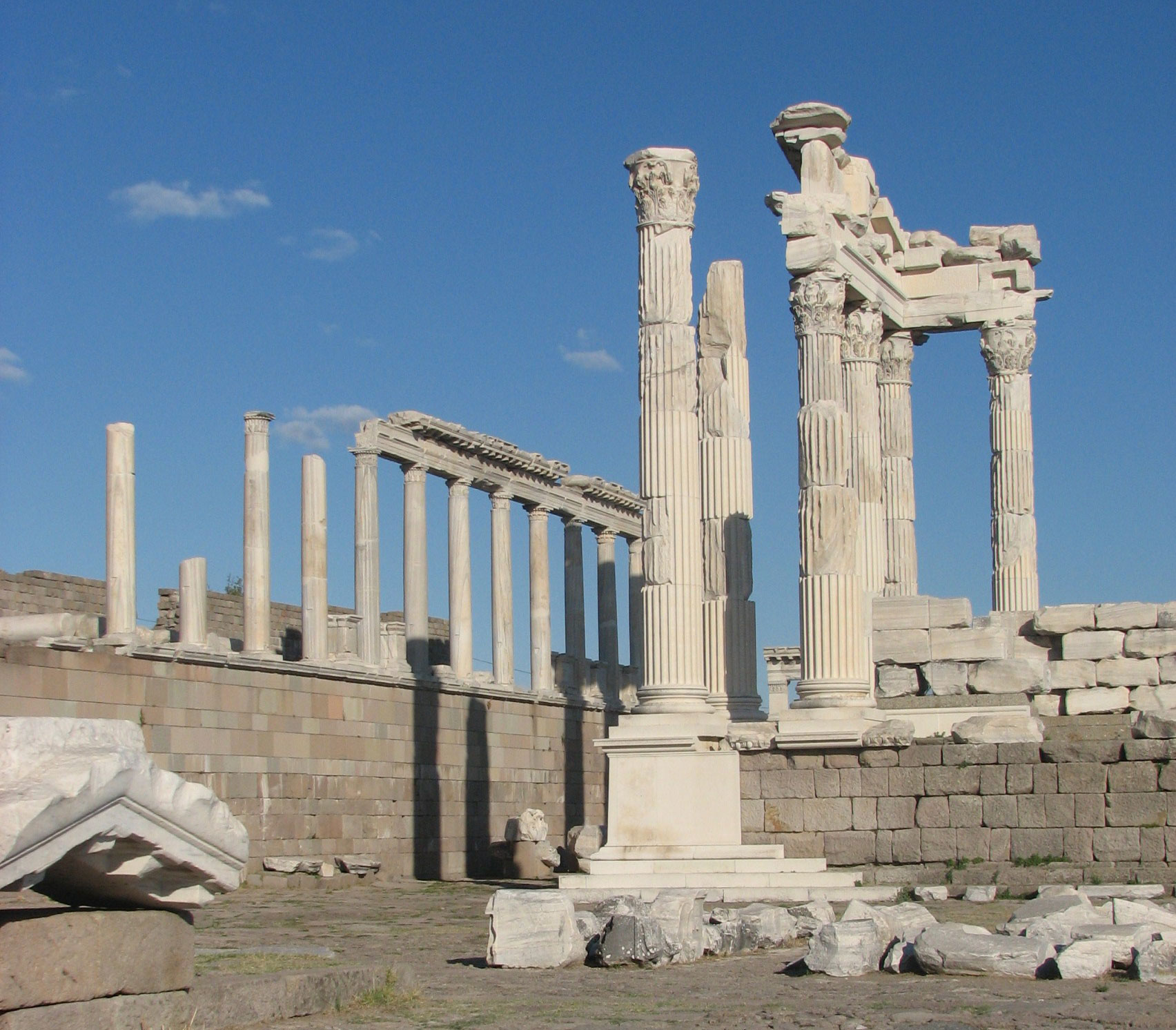
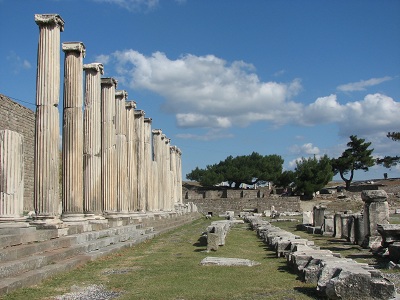
TOURISM STATISTCS:
The Number of Certificated Accommodation Facilities by Ministry of Culture and Tourism:
Accommodation
Facilities | Operation Certificated Facilities | Investment Certificated Facilities | TOTAL |
Number of Facilities | Number of Rooms | Number of Beds | Number of Facilities | Number of Rooms | Yatak
Sayısı | Number of Facilities | Number of Rooms | Number of Beds |
BERGAMA | 3 | 136 | 272 | 0 | 0 | 0 | 3 | 136 | 272 |
The List of Tourism Operation Certificated Facilities in the District
Class | Name | Address | Phone/ Fax | Website/ E-mail |
*** | Berksoy Oteli | Bahçelievler Mahallesi Atatürk Bulvarı No:128 35700 Bergama | 633 25 95 633 53 46 | www.berksoyhotel.com
berksoy@berksoyhotel.com |
*** | Otel La Bella | Fatih Mah. Atatürk Blv. No: 303 | 633 20 20 633 20 70 | http://www.hotel-labella.com /bergama/index.html |
THE LIST OF SIMPLE ACCOMMODATION CERTIFICATED FACILITIES
BERGAMA | BERGAMA |
BERGAMA | ANIL |
BERGAMA | AYVAZALİ |
BERGAMA | ELİT |
BERGAMA | ELİT 1 |
BERGAMA | HERA |
BERGAMA | ATHENA |
BERGAMA | GALENOS |
BERGAMA | ELEİA |
BERGAMA | ASUDE |
BERGAMA | ARİSTONİCUS |
BERGAMA | PERGAMON |
BERGAMA | BERLİN |
BERGAMA | ODYSESSY GUEST HOUSE |
BERGAMA | SANART LOCA
GARDEN & GUEST HOUSE |
BERGAMA | GOBİ |
BERGAMA | AKROPOLİS GUEST HOUSE |
BERGAMA | SELİNOS |
BERGAMA | SERAPİON |
BERGAMA | ATTALOS BERGAMA |
BERGAMA | BERGAMA TAŞ KONAK |
BERGAMA DISTRICT PUBLIC LIBRARY
Adress: Talatpaşa Mah. Abacıhan Sk. No:1 Bergama, Tel: 0(232) 631 28 69
Statistics of Books and Readers (First 6 Months of 2023)
Name of the Library | Number of Books | Number of Readers | Number of Members | Number of
Borrowed Materials |
Bergama District
Public Library | 14.533 | 3.889 | 3.942 | 1.476 |